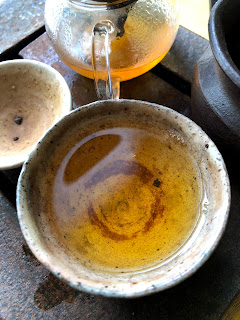I enjoyed the 2018 Zheng Si Long Ding Jia Zhai maocha for
its nice Yiwu like base favor and warming qi.
Very different from other tea of Zheng Si Long that I have sampled in
this recent focus of Zheng Si Long that Tea Encounter is offering. I wondered how similar this 2014 Zheng Si Long Ding Jai Zhai ($168.36 for 400g cake or $0.42/g) would be…
Dry leaves smell of a distant malty and hay like
sweetness. Deep darker odours.
First infusion has a nice warming spiciness to it with a
brown sugar like sweetness to it. It has
a mineral rock-like taste as well as woodiness to it. The returning sweetness is almost like a pear
and potato taste.
The second infusion starts with a mildly sweet woodiness there
is a short burst of warm spice sweetness that you would get from cinnamon that
is very mild and quick moving here. Its
liquor is a touch light still with sandy edges in the tongue and mouth.
The third infusion has the cinnamon almost brown sugar
sweetness in a lighter broth. It moves
to a mild woodiness before this same sweetness returns on the breath. It fades to an almost faint bubble gum
sweetness barely recognizable in the distance.
The fourth infusion has a fruitier, almost candy-like mixed
with cinnamon and spiced plumbs, kind of sweetness that shares the profile with
a mild woodiness. There is a bread taste
in there now as well an almost chicory, licorice taste too. The mouthfeel is becoming sticky now with
sandy edges in the mouth. Not as much in
the throat. The returning sweetness is higher
noted than the main body of the profile that peaks minutes later.
The fifth infusion has a deep lighter molasses taste too in
the returning sweetness is of spiced cinnamon and plumb. There are lighter fruity tastes almost bubble
gum that are faint in the aftertaste that contrast the deeper tastes. The mouthfeel is a touch sticky and slightly
grainy. The qi of this tea is warm and
comforting in the core but the forehead feels cool and the head a touch light.
The sixth infusion has a dense foresty deeper chicory and
licorice type of sweetness initially then returns as a lighter muted candy
sweetness. The mouthfeel is becoming
sandier and less sticky. A very mild
lingering menthol is in the breath later.
The seventh infusion has a more pronounced leathery brown surgery
like sweetness initially over a foresty taste then it returns as a higher,
almost fruit, sweetness. A faint
candy/bubble gum taste lingers on the breath.
The eighth I push a little harder with 5 seconds more than
flash and receive woody sweet notes with a fruity plumb subte menthol
finish. There is still that lingering
high-noted candy taste on the breath.
Even a cinnamon taste lingers minutes later in the mouth.
The ninth- I add 10 seconds to the flash and receive a woody
base taste with strong mellow low fruity tastes that look similar to the
eight. The qi can be felt in the chest
and a bit heavy in the digestion.
The tenth- I add 20 seconds and get a robust woody, slightly
warmer, spiced fruity plumb taste. It’s
a nice classic Yiwu taste for me. There
is that overly highnoted finish in here that I find appealing and gives this
tea some interesting depth to it- not just deeper Yiwu tastes nor just fuffy Yiwu
high notes.
The eleventh infusion I steep 40 seconds longer than flash
and have a really beautiful infusion full of dense flavor fruity flavours- both
high sweetness and low brown sugar sweetness.
The bubble gum sweetness is more throughout but strong in the aftertaste
the tongue coating is sticky and full.
The twelfth infusion, I’m steeping at about a minute and it
gives off deeper tastes with a licorice/ woody taste overall. The higher notes are embedded almost
overpowered by the deeper sweeter tones and woody even mushroom tastes
now. The thirteenth is much the same licorice,
almost medicinal, sweetness.
I push this tea into overnight steeps from here.
Overall this one is darker, deeper and warmer than any Zheng
Si Long I’ve tried. It’s so familiar in
many ways to the 2018 maocha that I’m confident enough that it came from the
same family in Ding Jia Zhai. Nice
warming feeling to this one.
Peace

















